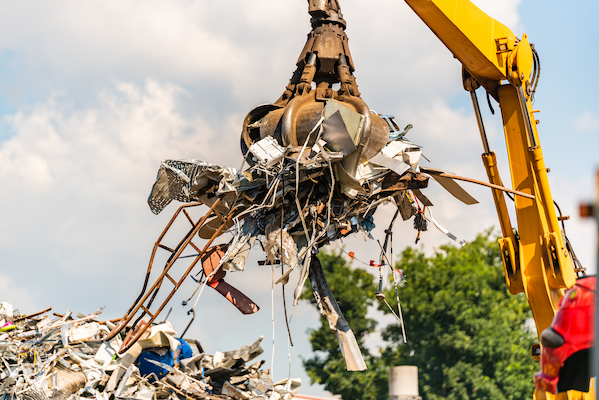
If you’re in the market for a new car or new electronic devices, you’re not alone. Across the globe, auto and electronics sales are surging. And behind the scenes, something else is surging: the push for the recycling of scrap metal.
Metals are in high demand right now among manufacturers, who are ramping up production to meet the insatiable appetite among consumers for new products. And metals are particularly valuable since they can be recycled, again and again, providing the ability to reuse them without altering their unique properties.
Scrap Metal Demand Skyrockets
Two factors are boosting the metals market. One is scrap metal recycling, which is increasing globally. Nearly 40 percent of worldwide steel production is made using recycled steel, while about 42 percent of crude steel in the U.S. is made of recycled materials.
What’s driving the increase in demand for scrap metal recycling? Market analysts say a key factor is a growing demand for metals in various end-use industries. That includes construction, electronics, and automotive.

The increasing industrialization globally has increased the value and appeal of using recycled metal products.
Consumer demand has helped ramp up the manufacturing of electronics, autos, and many other products, as well as a lot of new commercial and municipal construction projects.
Additionally, it’s also helped produce an increased awareness about the benefits of recycling metals. More and more countries are recognizing that recycling helps them preserve their natural resources and save them from depletion.
As a result, the global metal recycling market is expected to become a $400 billion market by the end of 2022. The industry is also projected to have an annual growth rate of 7 percent.
Why Do We Recycle Metals?
One message that leaders of a growing number of nations are trying to promote is that scrap metal has value, so it’s important not to simply discard it as unwanted junk. More and more nations are recognizing the need to ensure that it gets taken to a recycling operation.
Scrap is particularly valuable to the future manufacturing of new products that contain metals, since using recycled scrap repeatedly helps hold down the cost of production. As the American Iron and Steel Institute has noted, steel is the most recycled material on the planet, while other highly recycled metals include aluminum, brass, copper, gold, and silver.
The incentives are both financial and environmental. Production costs are lowered when manufacturers use recycled metals, and at the same time, our natural resources and our environment get preserved if we rely on recycled metals rather than manufacturing new products using virgin ore for raw materials.
Recycling of scrap has also become more prevalent because it has become a highly effective tool for global waste management. The more scrap we keep out of landfills, the healthier it is for both the environment and the economy.
The rules and regulations for waste recycling are typically very stringent, and the industry is held to high standards. So, it’s not just individuals and private businesses that are discovering they can recycle older scrap materials that no longer hold any use for them. Government agencies have been working actively to participate in and promote the recycling of these metals. This, too, has boosted the growth of the metal recycling market.
What Other Factors are Driving the Demand for Metals?
Higher consumer demand for electronics and autos is pushing up demand for scrap metal recycling, and so are construction projects that include the growth in infrastructure improvements and roadway and transportation expansions.
The automotive sector may be the one most dominating the metal recycling market. Manufacturers need high volumes of metals to make the body of a vehicle, as well as numerous other components of cars. A lot of metal scrap is needed from the automotive industry, which has made the automotive metal recycling material market a top aspect of the scrap recycling field.
This isn’t likely to change anytime soon. The strength of the global economy is also boosting the automobile industry as consumers have more money to purchase a car. And the automotive industry will be a major driver of demand for metals.
In the U.S. auto market alone, car sales have grown from 10 million sold in 2009 to more than 17 million by 2017, with overall sales at a historically high level. In fact, 2017 marked the third consecutive year of $17 million in sales.
And sales of light vehicles globally are expected to rise to a record 97.3 million units, according to an LMC Automotive forecast.
LMC is projecting a 2.1 percent increase in global demand for cars, with the biggest gains in South America and
Central and Eastern Europe.
Expectations are that automakers will put a focus this year on technology for self-driven cars and electric vehicles. In addition, the average car price is rising, and consumers are buying more expensive models and upgrading them with more expensive features, including automatic braking and lane detection warnings.
In 2017, buyers paid an average of $35,082 per car, up 2.3 percent from a year earlier.
Global auto sales in 2017 are expected to hit a record 94.5 million vehicles, up 2.5%, and fueled by continued strong demand in China, which is the largest market for auto sales.
Why is There a High Demand for Steel Impacting Recycling?
As demand for metals rises among manufacturers, so does the push to improve rates for scrap recycling.
The Global Metal Recycling Market was valued at $304,633 million in 2014, but projections are that it will increase to $446,472 million by 2022.
Because of the well-documented environmental benefits of recycling scrap and keeping it out of landfills – where the toxins within them pose dangers to the soil and groundwater — the governments of Canada, the United States, the United Kingdom, and others have worked to promote the metal recycling industry. That includes promoting better waste collection systems.

The Global Metal Recycling Market is growing quickly in countries experiencing rapid urbanization, like India and China. There has also been solid growth in the construction and automotive industry in both countries. Asia also happens to be the largest producer of steel, which has been contributing to the growing metal recycling market in the Asia-Pacific region.
The Institute of Scrap Recycling Industries has noted that the scrap recycling industry had a strong year in 2017, with a solid amount of economic activity, from jobs to exports, from the recycling of scrap metals.
Their recent report on the direct economic impact last year showed that the United States scrap recycling industry created 534,506 jobs and generated $13.2 billion in tax revenues for governments across the country.
Their report also estimated that the total economic activity generated by scrap recycling in the United States is $117 billion.
Conclusion
As consumers across the globe continue to buy record numbers of automobiles, electronic devices, and other products that are made using metals, the scrap recycling industry is poised for a strong year. The boom in the automotive industry alone is raising high demand for metals, and using recycled metals is far more cost-effective for manufacturers.
That high demand means there will be a need for more consumers and businesses large and small to bring their used scrap to an experienced firm like GLE Scrap Metal, which performs environmentally-friendly processing and recycling of all base and precious metals.
This family-owned and operated business will purchase, process, and re-integrate all recyclable base metals, which are supplied to domestic mills and global end-users to be transformed into new products.
GLE Scrap Metal also strives to utilize natural resources and help conserve energy.
To learn more, call GLE Scrap Metal at 855-SCRAP-88 and request a quote.



